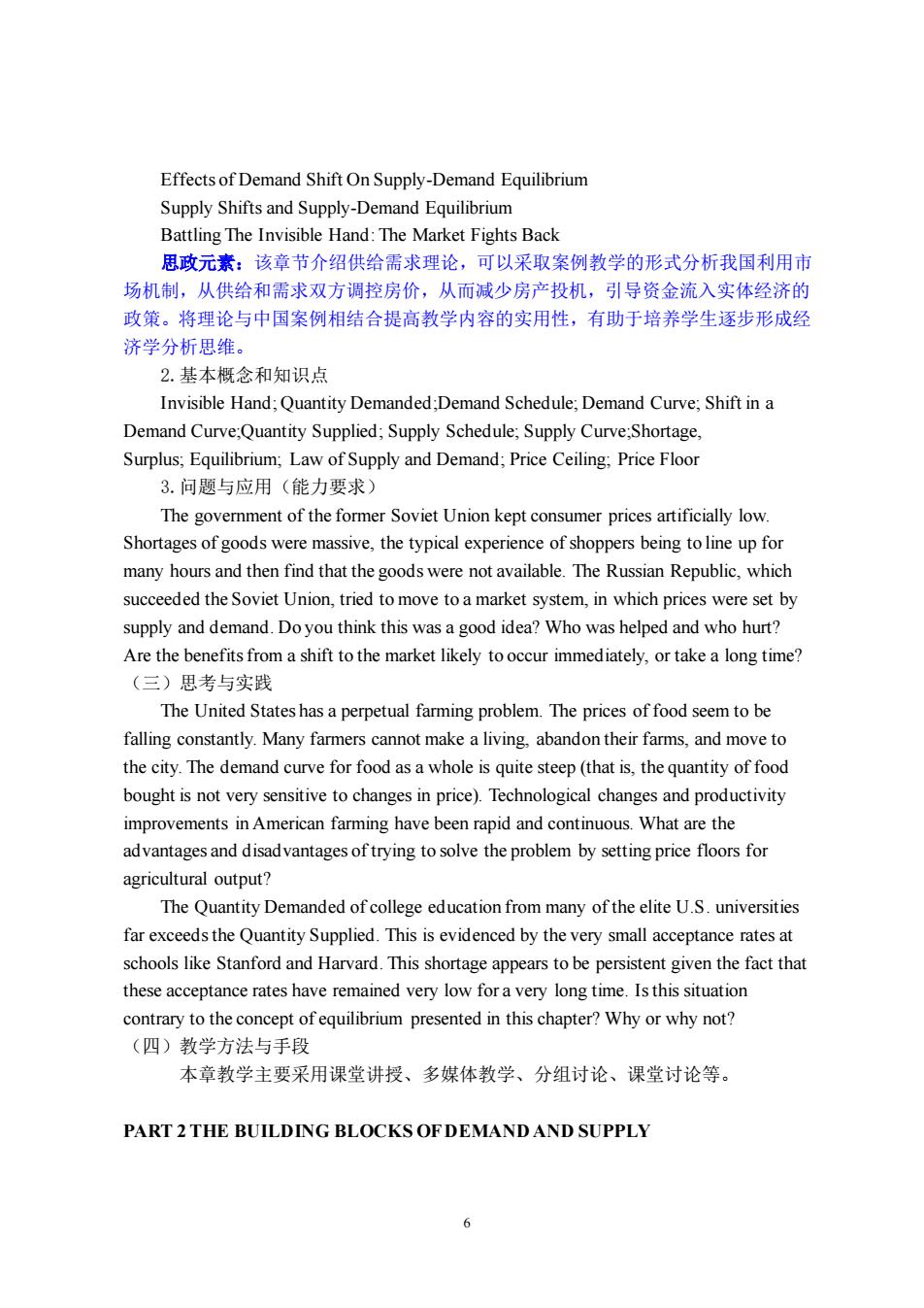正在加载图片...

Effects of Demand Shift On Supply-Demand Equilibrium Supply Shifts and Supply-Demand Equilibrium Battling The Invisible Hand:The Market Fights Back 思政元素:该章节介绍供给需求理论,可以采取案例教学的形式分析我国利用市 场机制,从供给和需求双方调控房价,从而减少房产投机,引导资金流入实体经济的 政策。将理论与中国案例相结合提高教学内容的实用性,有助于培养学生逐步形成经 济学分析思维。 2.基本概念和知识点 Invisible Hand;Quantity Demanded:Demand Schedule:Demand Curve:Shift in a Demand Curve:Quantity Supplied;Supply Schedule;Supply Curve:Shortage, Surplus;Equilibrium;Law of Supply and Demand:Price Ceiling:Price Floor 3.问题与应用(能力要求) The government of the former Soviet Union kept consumer prices artificially low Shortages of goods were massive,the typical experience of shoppers being to line up for many hours and then find that the goods were not available.The Russian Republic,which succeeded the Soviet Union,tried to move to a market system,in which prices were set by supply and demand.Doyou think this was a good idea?Who was helped and who hurt? Are the benefits from a shift to the market likely to occur immediately,or take a long time? (三)思考与实践 The United States has a perpetual farming problem.The prices of food seem to be falling constantly.Many farmers cannot make a living.abandon their farms.and move to the city.The demand curve for food as a whole is quite steep(that is,the quantity of food bought is not very sensitive to changes in price).Technological changes and productivity improvements in American farming have been rapid and continuous.What are the advantages and disadvantages oftrying tosolve the problem by setting price floors fo agricultural output? The Quantity Demanded of college education from many ofthe elite U.S.universities far exceeds the Quantity Supplied.This is evidenced by the very small acceptance rates at schools like Stanford and Harvard.This shortage appears to be persistent given the fact that these acceptance rates have remained very low for a very long time.Is this situation contrary to the concept of equilibrium presented in this chapter?Why or why not? (四)教学方法与手段 本章教学主要采用课堂讲授、多媒体教学、分组讨论、课堂讨论等。 PART 2THE BUILDING BLOCKSOFDEMAND AND SUPPLY 6 6 Effects of Demand Shift On Supply-Demand Equilibrium Supply Shifts and Supply-Demand Equilibrium Battling The Invisible Hand: The Market Fights Back 思政元素:该章节介绍供给需求理论,可以采取案例教学的形式分析我国利用市 场机制,从供给和需求双方调控房价,从而减少房产投机,引导资金流入实体经济的 政策。将理论与中国案例相结合提高教学内容的实用性,有助于培养学生逐步形成经 济学分析思维。 2.基本概念和知识点 Invisible Hand; Quantity Demanded;Demand Schedule; Demand Curve; Shift in a Demand Curve;Quantity Supplied; Supply Schedule; Supply Curve;Shortage, Surplus; Equilibrium; Law of Supply and Demand; Price Ceiling; Price Floor 3.问题与应用(能力要求) The government of the former Soviet Union kept consumer prices artificially low. Shortages of goods were massive, the typical experience of shoppers being to line up for many hours and then find that the goods were not available. The Russian Republic, which succeeded the Soviet Union, tried to move to a market system, in which prices were set by supply and demand. Do you think this was a good idea? Who was helped and who hurt? Are the benefits from a shift to the market likely to occur immediately, or take a long time? (三)思考与实践 The United States has a perpetual farming problem. The prices of food seem to be falling constantly. Many farmers cannot make a living, abandon their farms, and move to the city. The demand curve for food as a whole is quite steep (that is, the quantity of food bought is not very sensitive to changes in price). Technological changes and productivity improvements in American farming have been rapid and continuous. What are the advantages and disadvantages of trying to solve the problem by setting price floors for agricultural output? The Quantity Demanded of college education from many of the elite U.S. universities far exceeds the Quantity Supplied. This is evidenced by the very small acceptance rates at schools like Stanford and Harvard. This shortage appears to be persistent given the fact that these acceptance rates have remained very low for a very long time. Is this situation contrary to the concept of equilibrium presented in this chapter? Why or why not? (四)教学方法与手段 本章教学主要采用课堂讲授、多媒体教学、分组讨论、课堂讨论等。 PART 2 THE BUILDING BLOCKS OF DEMAND AND SUPPLY